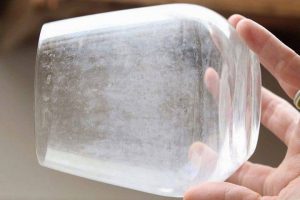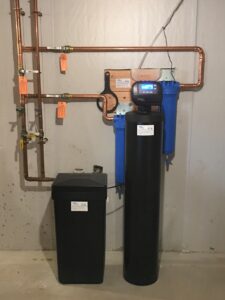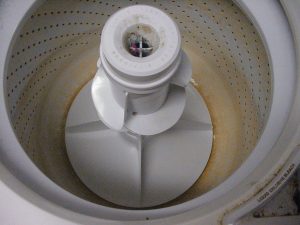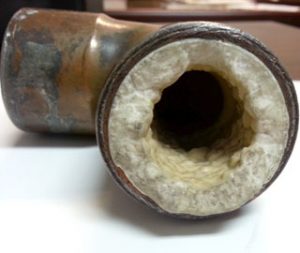The main hard water minerals, magnesium and calcium, can be found in Southborough, along with iron and manganese (“The stainers”). Water softening will greatly improve your water if you have these minerals present. These common regional contaminants can be removed with a water softener and/or a properly specified sediment filter depending on whether the contaminants are in particulate form or in solution (dissolved)

Hard Water Scale
Manganese and Iron are naturally occurring minerals commonly found in New England’s water supply. Together, they are commonly referred to as “The Stainers” in the water treatment industry. Hard water is evidenced by white scale build-up in the shower, faucets, glassware, dishes and other plumbing fixtures. Hard water also forms inside the piping distribution system, potentially restricting water flow and straining water using appliances which can reduce their useful lives significantly. For more on hard water, see link at hard water usgs.

High Efficiency Water Softener
IRON can show up in two forms; Dissolved in solution (ferrous form – clear water iron, can’t see until it stains) or precipitated (ferric) particulate iron which you can see in the water. Typical symptoms of iron in your water include Reddish/Brown stains in sinks, tub, dishwasher, laundry and/or Metallic taste. Iron may also show up in the form of Iron bacteria. Although harmless, iron bacteria can form gelatinous growths that my plug pipes or break free in slugs of dirty iron-laden water with unpleasant tastes and odors.

Dissolved Iron Staining
The EPA drinking water regulations set a recommended secondary maximum contaminant level of iron at .3 milligrams per liter. The reason they call it a secondary contaminants is that iron isn’t considered a primary health threat. Sediment filters are effective in removing particulate iron from the water and would typically be installed before the water softener.
MANGANESE also shows up dissolved in solution or precipitated (particulate) which you can see in the water. Typical symptoms of manganese in your water include brownish–black staining in the dishwasher and other plumbing fixtures. Manganese may also show up in the form of manganese bacteria. Although harmless, manganese bacteria can form gelatinous growths that my plug pipes or break free in slugs of dirty manganese-laden water with unpleasant tastes and odors. The U.S. EPA drinking water regulations set a recommended secondary maximum contaminant level of manganese at .05 milligrams per liter. Manganese is also considered a secondary health threat, however at certain high levels, especially in children, can be a health threat. As with Iron, a water softener will be effective in removing dissolved manganese from the water.




